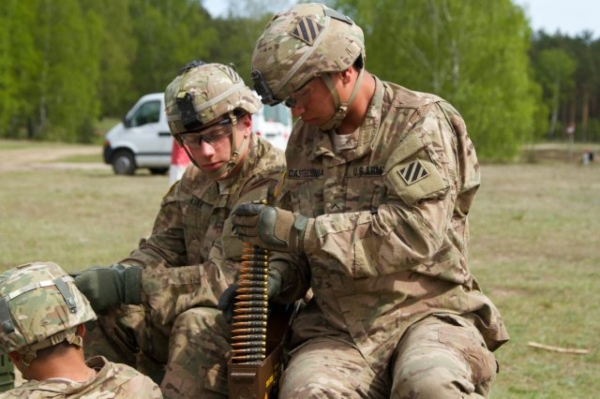Army Cavalry Scouts (MOS 19D) are responsible for being the “eyes and ears” of the Army.
MOS 19D work alongside the commander during battle in order to communicate information.
An Army Cavalry Scout may engage the enemy in the field, track and report enemy activity, as well as direct the employment of weapon systems.
Education, Qualifications, Training, and Duty Stations
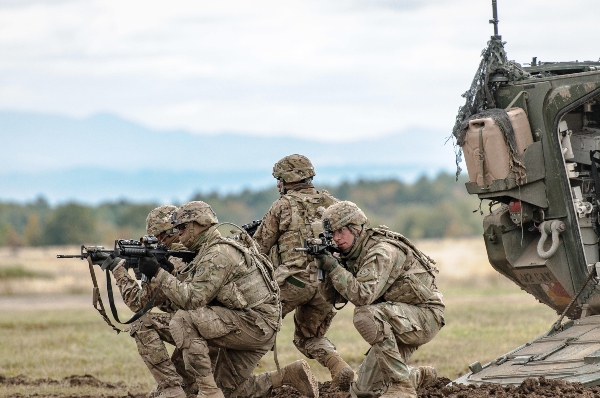
An Army Cavalry Scout (MOS 19D) serves a critical function in the U.S. Army.
As a result, there are required Education, Qualifications, Training, and Duty Stations needed to become 19D MOS.
Related Article – Army Infantryman (MOS 11B): Career Details
Education
In order to join the U.S. Army, you must meet the basic qualifications and requirements.
In terms of education, you are required to have a high school diploma or GED equivalent.
You also must be 17 years of age to join (with parental consent), or 18 years old without.
Then you need to complete the Armed Services Vocational Aptitude Battery (ASVAB).
In order to become an Army Cavalry Scout (MOS 19D) you must score Combat (CO): 87 on the ASVAB.
Qualifications
Army Scouts are in excellent physical condition.
They are able to work as part of a team and under intense pressure.
After completing the required score on the ASVAB, the next step is to pass an eye exam.
Scouts must have correctable vision of 20/20 in one eye and 20/70 in the other eye. Normal color vision is required, however, this can be waived if you can pass the red/green color test.
There is no Department of Defense security clearance needed for MOS 19D, which saves you from an extensive background check.
Additionally, 19D MOS have the option of also considering becoming a Cavalry Scout Sniper.
However, it is not a requirement of becoming an Army Cavalry Scout.
NOTE: MOS 19D was previously closed to women. However, the Army changed its stance in 2017. Now female soldiers can also become Army Scouts.
Training
All Army recruits are required to complete Basic Combat Training (BCT).
It lasts 10 weeks long and will make sure that you are physically and mentally prepared for life in the U.S. Armed Forces.
Army Cavalry Scouts (MOS 19D) are a little different from other military careers in that they go through One Station Unit Training (OSUT) at the same time as basic training.
When BCT is combined with OSUT, it lasts 22 weeks for recruits seeking to become MOS 19D.
All the instruction takes place at Fort Moore, Georgia.
Recruits will learn basic soldering skills, how to prepare ammunition, handle high-powered weapons, perform navigation, and collect data to classify routes, tunnels, and bridges.
The Army mentions that in order to succeed during OSUT training for an Army Cavalry Scout, it serves you well to demonstrate a readiness to accept new challenges, work well in teams, and show peak physical and mental shape.
Related Article – Army MOS List: A list of all 159 jobs
Duty Stations
Those serving in the Army as an MOS 19D can expect to be potentially based at one of the following duty stations:
Inside the Continental US (CONUS)
- Fort Bliss, TX
- Fort Campbell, KY
- Fort Carson, CO
- Fort Cavazos, TX
- Fort Drum, NY
- Fort Eustis, VA
- Fort Irwin, CA
- Fort Johnson, LA
- Fort Liberty, NC
- Fort Moore, GA
- Fort Riley, KS
- Fort Stewart, GA
- Joint Base Lewis-McChord, WA
Outside the Continental US (OCONUS)
- Fort Wainwright, AK
- Joint Base Elmendorf-Richardson, AK
- USAG Bavaria, Germany
- USAG Hawaii
- USAG Yongsan-Casey, South Korea
What does an Army Cavalry Scout Do?
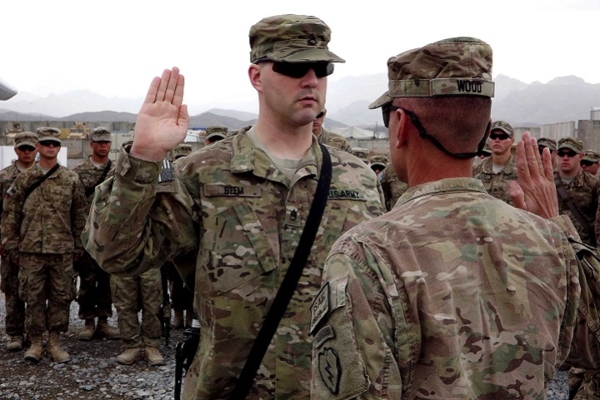
An Army Cavalry Scout (MOS 19D) gathers battlefield information about the enemy and also serves other duties for infantry.
Scouts are highly valued by commanders for their ability to gather important information about the enemy.
The information a scout collects can include information about enemy positions, weapons, vehicles, and recent activity.
The ultimate goal of MOS 19D is to “extend the battlefield” by gathering critical information that will support Infantry Divisions of the U.S. Army.
Related Article – Army Firefighter (MOS 12M): Career Details
Information
An Army Scout is a gatherer of information.
Though 19D MOS traditionally stay mounted in vehicles, the job does require long distances on foot as well.
As a result, Scouts are very well-conditioned and keen on gaining intel on the enemy without getting compromised.
They conduct mounted and dismounted navigation, collect data about infrastructure like bridges and tunnels, and work at observation and listening posts.
The information an Army Scout gathers about the enemy allows commanders to make better-informed decisions on the battlefield.
For example, a Scout can inform a commander on how many troops and vehicles are stationed on the other side of the battlefield, which allows the commander to decide if reinforcements are necessary, or even to order a retreat.
Consequently, Army Scouts can potentially save countless lives based on the information they collect.
Combat Roles
An Army Cavalry Scout (MOS 19D) is sometimes defined as “the first line of defense for Army units”.
Scouts not only help find enemy positions, but they also assist in a number of other roles during combat.
For example, like fellow combat troops, they may load and fire weapons, secure and stow ammunition, as well as repair and maintain Army vehicles.
They are considered “jacks of all trades” for their ability to perform multiple combat roles in the Infantry Division.
Scouts may also assist with the placement or removal of mines.
Some also elect to become snipers so they have the ability to also act as long-distance marksman.
Lastly, the information they collect about the enemy helps with navigation and may include details about the terrain and weather in addition to enemy location.
What does an Army Cavalry Scout make?
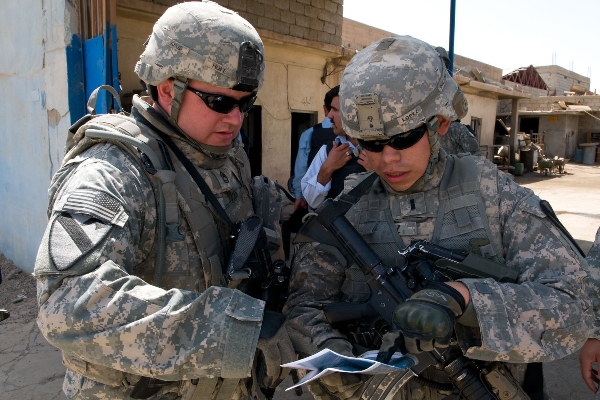
The U.S. Army dictates pay based on years of service and Army Rank.
In order to gain a better understanding of what you can expect to make based on Army rank, reference the table below:
| Insignia | Pay Grade | Rank | Abbreviation | Minimum Monthly Pay |
|---|---|---|---|---|
| E-1 +4 months | Private | PVT | $1,917.60 | |
| E-2 | Private Second Class | PV2 | $2,149.20 | |
| E-3 | Private First Class | PFC | $2,259.90 | |
| E-4 | Specialist | SPC | $2,503.50 | |
| E-4 | Corporal | CPL | $2,503.50 | |
| E-5 | Sergeant | SGT | $2,730.30 | |
| E-6 | Staff Sergeant | SSG | $2,980.50 | |
| E-7 | Sergeant First Class | SFC | $3,445.80 | |
| E-8 | Master Sergeant | MSG | $4,957.20 | |
| E-8 | First Sergeant | 1SG | $4,957.20 | |
| E-9 | Sergeant Major | SGM | $6,055.50 | |
| E-9 | Command Sergeant Major | CSM | $6,055.50 | |
| E-9 | Sergeant Major of the Army | SMA | $6,055.50 |
Benefits
The U.S. Army offers several benefits in addition to your salary:
- Medical Insurance
- Vacation Time
- Special Pay
- Retirement
- Housing: Allowances for living expenses, utilities, and maintenance.
- Food: Allowance for the on-base dining hall and access to tax-free department and grocery stores.
- Education: Army members can earn full tuition, merit-based scholarships, allowances for books and fees, plus an annual stipend for living expenses.
Job Reviews
The role of a Cavalry Scout (MOS 19D) in the U.S. Army is very herald.
As a result, the job reviews on sites like Indeed.com and GlassDoor.com are very positive.
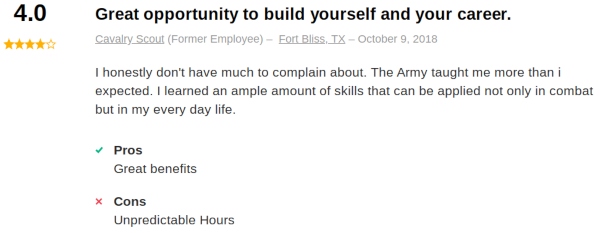
Though there are many positives to MOS 19D, as one reviewer put it, “ultimate sacrifice” is mandatory for this Military Occupational Specialty:
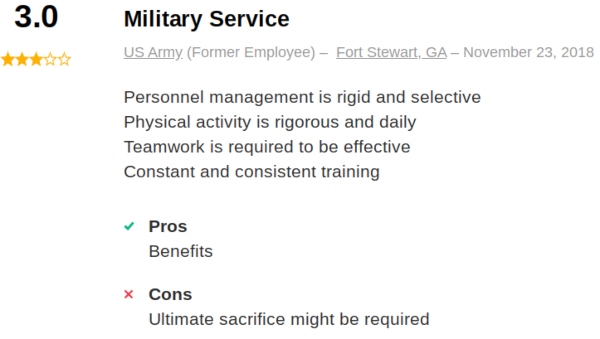
However, a “brotherhood that is never broken” and the living benefits are highly desired of being part of the U.S. Army:
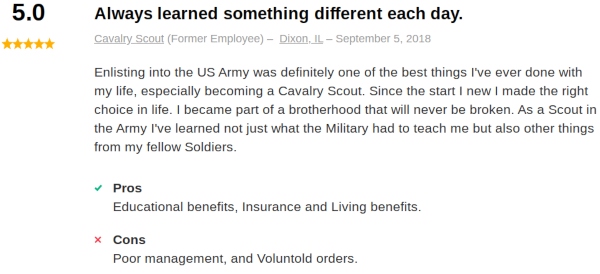
Civilian Job Opportunities
It is hard to find a job equivalent to an Army Cavalry Scout (19D MOS) considering the role is combat-oriented.
However, many of the skills you learn in the U.S. Armed Forces contribute well to any civilian job.
Also, the specialized skills you attain driving trucks, surveying, and operating radio equipment are beneficial to civilian careers like working as a police officer or security guard.
Related Article – Army Interpreter (MOS 09L): Career Details
Summary
Army Cavalry Scouts (MOS 19D) are nicknamed “the eyes and ears” of the Army as well as its “first line of defense”.
The role of 19D MOS is tremendously important and the information you gather about the enemy could save countless lives on the battlefield.
Resources:
- https://www.goarmy.com/careers-and-jobs/browse-career-and-job-categories/combat/cavalry-scout.html
- https://www.indeed.com/cmp/Cavalry-Scout/reviews
- https://www.glassdoor.com/Reviews/US-Army-19D-Cavalry-Scout-Reviews-EI_IE41322.0,7_KO8,25.htm
- Ikon Pass Military Discount: Learn How To Save Big - January 31, 2025
- RTIC Military Discount: Find Out How To Save Big on Gear - January 30, 2025
- Traeger Military Discount: Learn How To Save Big on Smokers - January 28, 2025
General FAQ
Do Cavalry scouts see combat?
MOS 19D, or Cavalry scouts, is a combat MOS. This means that they indeed do routinely see combat, about as much as any other combat MOS in the Army.
What exactly do Cavalry scouts do?
Considered the 'eyes and ears of the Army', the primary job purpose of Cavalry scouts is to inform senior leadership of enemy troop movements, environmental conditions of the battlefield, and other pertinent info.
Is it a dangerous job?
Since Cavalry scouts are often in direct contact with the enemy, their job can be considered one of the most dangerous jobs the Army has to offer.
How much are Cavalry scouts paid?
The average salary for a Cavalry scout with 3 years in the Army and a rank of E-4 will earn approximately $2,263 per month.
Are Cavalry scouts considered infantry?
While they are not technically an infantry unit, Cavalry scouts often embark on the same types of missions that infantry units do.

